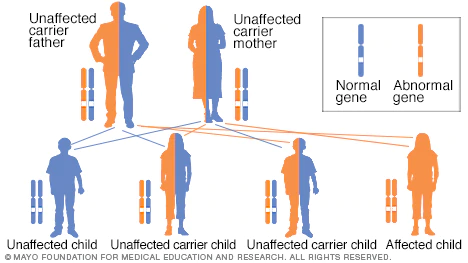Autosomal Recessive Disorder
Introduction
 Image courtesy of MAYO CLINIC Opens in new window
Image courtesy of MAYO CLINIC Opens in new windowAn autosomal recessive disorder occurs when a person possesses two mutant alleles that were inherited from heterozygous parents. For autosomal recessive diseases, an individual with one normal allele does not manifest the disease because the normal gene copy is able to compensate, and prevent the disease from occurring.
Autosomal recessive disorders exhibit horizontal transmission, meaning that if the phenotype appears in more than one family member, it is typically in the siblings of the proband, not in parents, offspring, or other relatives. If both parents are carriers of a mutated allele, 25% of offspring have the autosomal recessive disease.
A common autosomal recessive disease is cystic fibrosis Opens in new window. If both members of a couple are carriers for cystic fibrosis, they have a 25% chance of producing at least one child that has the disease. That’s because both the father and mother are heterozygous for the allele that codes for cystic fibrosis, and each has 50% probability of contributing the CF allele.
The probability of both partners of the couple contributing CF alleles in one fertilization event is calculated by multiplying the probability of each event happening independently. The probability the father contributes his CF allele is 50% or 0.5; the probability the mother contributes her CF allele is 50% or 0.5. the probability he contributes his allele and she contributes her allele is 0.5 x 0.5 = 0.25 or 25%.
Etiology
Consanguinity
Some autosomal recessive disorders are more common among people of certain religious or ethnic groups because people belonging to those groups tend to marry within the group. After many generations, everyone within the group shares common ancestry.
When cousins or other close relatives marry, such relationships are referred to as consanguineous unions, matings between individuals related with same blood who are second cousins or closer. Such individuals are at increased risk for an autosomal recessive disorder because there is a higher likelihood that both individuals carry the same recessive mutation.
The genetic risk to the offspring of consanguineous union between related people is not as great as is sometimes imagined. For marriages between first cousins, the absolute risks of abnormal offspring, including not only known autosomal recessive diseases but also stillbirth, neonatal death, and congenital malformations, is 3% to 5%, about double the overall background risk of 2% to 3% for offspring born to any unrelated couple.
Consanguineous union at the level of third cousins or more remote relationships is not considered to be genetically significant, and the increased risk of abnormal offspring is negligible in such cases.
Although the incidence of cousin marriage is low (~1 to 10 per 1000) in many populations in Western societies today, it remains relatively common in some ethnic groups, for example, in families from rural areas of the Indian subcontinent, in other parts of Asia, and in the Middle East, where between 20% and 60% of all marriages are between cousins. In general, however, the frequency of first-cousin marriages and consanguinity in general, is declining in many traditional societies.
Inbreeding
Another factor closely related to consanguinity or consanguineous union is inbreeding.
Inbreeding describes the situation in which individuals from a small population tend to choose their mates from within the same population for cultural, geographical, or religious reasons. In this situation, the parents may consider themselves unrelated but still may have common ancestry within the past few generations.
Just as with consanguineous union, inbreeding increases the chance that individuals will be homozygous for an allele inherited from a common ancestor. Thus, in taking a family history, it is important to ask not only about consanguinity but also about the geographical origins of ancestors, especially if a couple seeking counseling is of similar ethnic or geographical origin.
As with consanguineous matings, it is possible to estimate a coefficient of inbreeding for individuals in a population even if they are not known to be related to each other.
Although we make a distinction between consanguineous union occurring within a family and inbreeding, which occurs between unrelated individuals from the same small ethnic group, an increased risk for mating between heterozygous carriers of autosomal recessive disorders exists in both situations.

